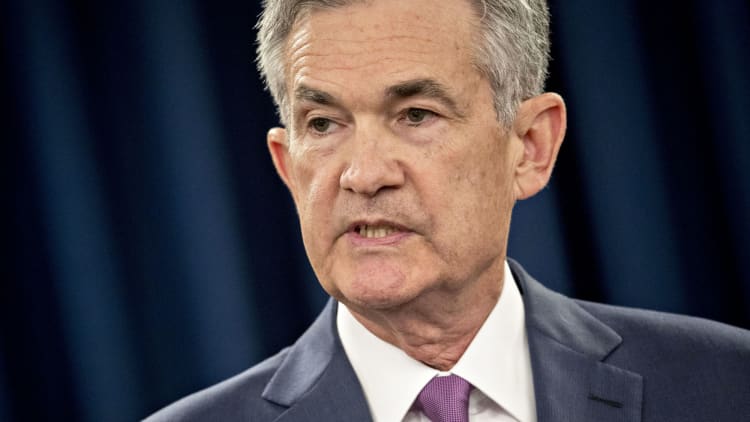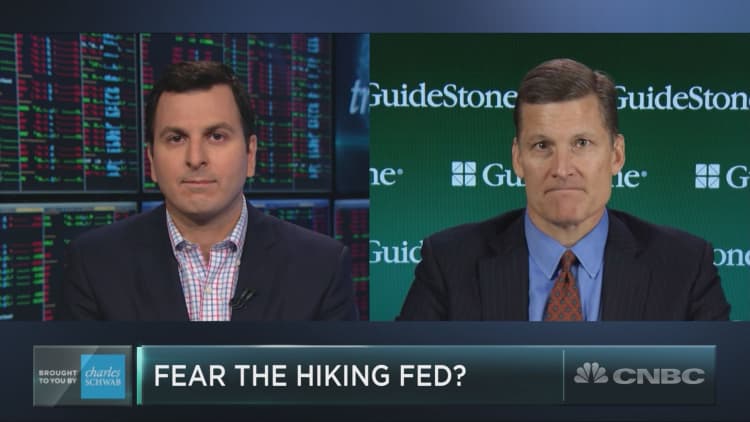The Federal Reserve's effort earlier this month to tamp down the rise of its benchmark interest rate already isn't running as smoothly as officials might have anticipated.
At its June 12-13 meeting, the Federal Open Market Committee hiked its target overnight funds rate 0.25 points to a range of 1.75 percent to 2 percent. At the same time, it raised the interest on excess reserves 0.2 points to 1.95 percent.
The move was meant to contain the rise of the funds rate, which historically trails the IOER. In the weeks running up to the meeting, the funds rate closed within 5 basis points, or 0.05 percent, of the IOER, instead of staying within the midpoint of the target range as it has done since the Fed began hiking the funds rate in December 2015.
However, in the days since, the funds rate has moved even closer to the IOER.
As of Friday trading, the funds rate has edged up to 1.92 percent — now just 3 basis points away from the IOER, though still 8 points away from the top of the trading range set at this month's meeting.
For the Fed, it's a potential headache as the central bank sees to unwind the programs it initiated the pull the economy out of the financial crisis. The Fed kept interest rates at historically low levels and bought up nearly $4 trillion worth of Treasurys and mortgage-backed securities in an effort to keep rates anchored and maintain liquidity flow through the financial system.

For investors, it means that continued upward pressure on the funds rate as the Fed unwinds the bonds on its balance sheet could keep the FOMC at bay in its stated intention to continue hiking interest rates.
"Here we are, and I think they will be lucky to get one more done this year, because whenever the curve flattens the market's going to look at the Fed and say, 'Really?' and the Fed will have to blink," said Christopher Whalen, head of Whalen Global Advisors, an investment bank consultancy. "They're telling everyone there's going to be a couple more rate increases, and that's fanciful."
In addition to approving the rate hike, the FOMC got more aggressive with its forecast, indicating two more increases in 2018 and at least three in 2019.
However, the rise in the funds rate to near the top of its range along with a general decline in the difference between government debt yields of various maturities has raised questions about how much tighter the Fed can get. Though the committee was fairly explicit at the meetings about its intentions, and Chairman Jerome Powell last week also affirmed his belief that the Feds should keep hiking, traders in the funds market are assigning just a 45 percent chance of two more increases this year.
Internally, Fed economists saw the IOER adjustment as a small technical adjustment. But the continued upward pressure could change the rate calculus, as well as the extent of the balance sheet reduction. In a program that started in October 2017, the central bank is allowing a capped level of proceeds from its bond holdings to run off each month and is reinvesting the rest.
Whalen thinks the Fed has made a "fundamental screw-up" in the process by focusing solely on short-term reverse repo operations to control rates when yields are compressing across the duration curve.
The New York Fed, which runs the central bank's trading operations, declined a request for comment.
"Jay Powell should be managing the yield curve," Whalen said, using the chairman's nickname. "He should make sure the curve remains positive, which means he can't just wait for the portfolio to run off. He's got to be willing to sell the long end of the market. It wouldn't have a huge impact, but it would at least keep the curve positive."
What's next
Taking substantial action at this point, though, would send what could be a negative message to the market — that the balance sheet runoff, which former Chair Janet Yellen said would be "like watching paint dry," is running into snags and requires corrective action.
However, the Fed would have no choice if there are indications that it can't control the market movements, particularly considering the record level of Treasury debt the government has issued this year.
"This is exposing how tenuous that process is and the great unknown of what's going to happen," said Danielle DiMartino Booth, founder of economic consulting firm Money Strong and a former advisor to former Dallas Fed President Richard Fisher for nine years, including during the financial crisis. "These are plumbing issues that are coming back to haunt the Fed."
The flood of debt issuance combined with rate hikes and the balance sheet runoff is creating a tightening in financial conditions that the Fed may not have anticipated.
While Powell and others have touted the strength of the economy as justification for raising rates, the yield curve compression is signaling to some market participants that a slowdown may not be that far in the distance. An inverted yield curve, in which longer-term yields are lower than short-term, indicate that markets believe growth will be slower in the future.
"There are a lot of things going on right now, none of which are favorable for the Fed trying to create a perception that they've got everything under control," DiMartino Booth said.
Other issues also are at play in terms of the funds rate closing in on the IOER level.
Smaller banks "have been much more aggressive" in expanding lending than large banks, causing them to have to borrow from bigger institutions. That is creating most of the demand in the short-term funds market as big banks already have nearly $2 trillion in reserves at the Fed. That in turn is driving the funds rate higher, said Steve Blitz, chief U.S. economist at TS Lombard.
Blitz said there remains some confusion about how high the level of reserves needs to be at the Fed, creating uncertainty about how far the Fed should go in tightening.
As for the effort to keep the funds rate in check, "it doesn't seem to be working," he added.
Whalen suggested the Fed should revisit a process known as "Operation Twist" that it conducted amid the bond buying. The Fed in that instance bought long-term holdings and sold an approximately equal amount of shorter-term Treasurys in an order to drive down rates farther out on the curve. Whalen said the Fed should reverse that process this time to keep shorter-term rates low, without expanding the size of its balance sheet.
Whether the Fed would be willing to do such an about-face at this stage, though, is in doubt.
"You're talking about a massive reversal of position," DiMartino Booth said. "I think that would send a very bad signal for markets."
Correction: An earlier version misstated how Operation Twist worked.
WATCH: Quantitative tightening underway



